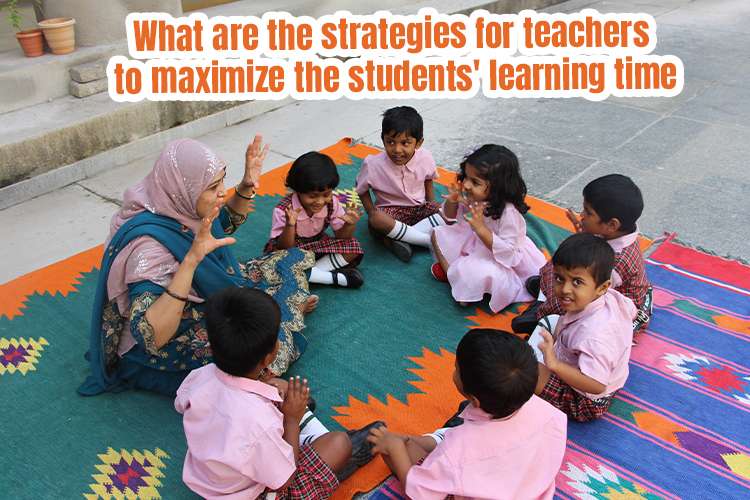Learning time in the ever-evolving field of education, teachers play a crucial role in shaping the minds and futures of their students. With limited classroom hours and a growing list of curriculum objectives to meet, it becomes imperative for educators to employ effective strategies that maximize students’ intellectual growth time.
Time management holds paramount importance for teachers as it not only ensures the comprehensive coverage of curriculum objectives but also allows for meaningful interactions with students. By utilizing proven techniques, teachers can create an environment conducive to enhanced engagement, active participation, and meaningful intellectual growth experiences.
Why is time management important for teachers?
Time management is a vital skill for teachers as it directly impacts students’ educational journey. Efficient allocation of instructional time ensures that educators cover the required content while allowing ample opportunity for reinforcement and consolidation. By optimizing intellectual growth time, teachers can enhance students’ understanding, critical thinking skills, and overall academic performance.
Effective time management is crucial for teachers as it empowers them to create a well-balanced and productive cognitive development environment. By skillfully managing their time, educators can allocate sufficient attention to individual student needs, provide timely feedback, and engage in professional development activities, ultimately fostering a culture of continuous improvement and maximizing student success.
How can teachers prioritize cognitive development time?
By strategically setting goals, orchestrating seamless transitions, and embracing innovative teaching methods, educators can create a classroom where time becomes a catalyst for boundless growth and exploration. Let’s delve into the transformative strategies that empower teachers to optimize every second of students’ educational journey via these techniques:
1. Clear instructional goals:
Setting clear and measurable cognitive development objectives enables teachers to prioritize essential concepts and skills, focusing on what matters most.
2. Sequencing and scaffolding:
Teachers can structure lessons by breaking down complex concepts into manageable steps, gradually increasing the difficulty level. This approach helps students build a strong foundation before tackling more challenging material.
3. Effective transitions:
Smooth transitions between cognitive development tools reduce downtime and maintain students’ engagement. Teachers can plan transitions strategically, using cues, signals, or quick energizers to seamlessly shift from one task to another.
4. Elimination of time wasters:
Identifying and eliminating non-essential or distractions can significantly optimize cognitive development time. Minimizing disruptions, such as excessive administrative tasks or unnecessary interruptions, ensures a focused and productive classroom environment.
When is an engaging educational environment beneficial?
An engaging Educational environment fosters curiosity, active participation, and collaboration among students. It ignites passion for learning, promotes retention and helps with a deeper understanding of the subject matter. Here’s how teachers can create such an environment:
1. Incorporating technology:
Integrating educational technology tools, such as interactive presentations, and multimedia resources captivates students’ attention and makes learning more interactive and enjoyable.
2. Varied instructional approaches:
Employing a mix of teaching strategies, such as group discussions, hands-on engagement, project-based assignments, and peer-to-peer collaboration, caters to diverse learning or cognitive styles and keeps students engaged throughout the lesson.
3. Utilizing visual aids:
Visual aids, including charts, diagrams, and infographics, enhance comprehension and memory retention. These visual representations make complex information more accessible and facilitate active comprehension.
4. Active enrichment of understanding strategies:
Encouraging pupils to actively participate in the enrichment of understanding process through challenges like debates and problem-solving tasks enhance their critical thinking skills and fosters a deeper understanding of the subject matter.
How can teachers extend opportunities?
Enrichment of understanding doesn’t solely take place within the four walls of a classroom. Teachers can maximize students’ understanding time by extending educational opportunities beyond traditional boundaries. Here are a few ways to achieve this:
1. Field trips:
Organizing educational field trips allows students to explore real-world applications of what they learn in the classroom. By connecting theoretical knowledge with practical experiences, students gain a deeper appreciation for the subject matter.
2. Guest speakers:
Inviting experts or professionals from relevant fields to share their insights and experiences exposes students to different perspectives and enriches their understanding experience.
3. Community involvement:
Encouraging students to engage in community service projects or participate in local events broadens their horizons and fosters a sense of social responsibility. These experiences provide valuable life skills and enhance their understanding of real-world issues.
How to empower students through strategic teaching?
By implementing the given below strategies, teachers can seize the opportunity to optimize students’ learning time, nurture their passions, and unlock their full potential.
1. Encouraging active learning
Shift from passive learning to active engagement, fostering deeper understanding and critical thinking.
- Promote collaborative group activities
- Incorporate hands-on experiments and projects
- Encourage student-led discussions and debates
2. Effective classroom management
Establish a well-structured and productive classroom environment to optimize learning opportunities.
- Develop clear expectations and routines
- Utilize effective transition strategies
- Implement behavior management techniques
3. Differentiated instruction
Recognize and cater to the diverse knowledge acquisition needs of students to promote personalized learning experiences.
- Use flexible grouping strategies
- Offer differentiated assignments and assessments
- Provide individualized support and resources
As teachers strive to maximize students’ knowledge acquisition time, employing effective strategies is paramount. By prioritizing time management, creating an engaging knowledge acquisition environment, and extending acquisition opportunities beyond the classroom, educators can unlock their students’ full potential. These strategies empower students to become lifelong learners, equipped with the skills and knowledge necessary for success in an ever-changing world.
Remember, effective teaching goes beyond delivering information. It encompasses creating an environment that encourages active participation, and instills a love for knowledge acquisition. By implementing these strategies, teachers can truly make a difference in their students’ educational journeys.




